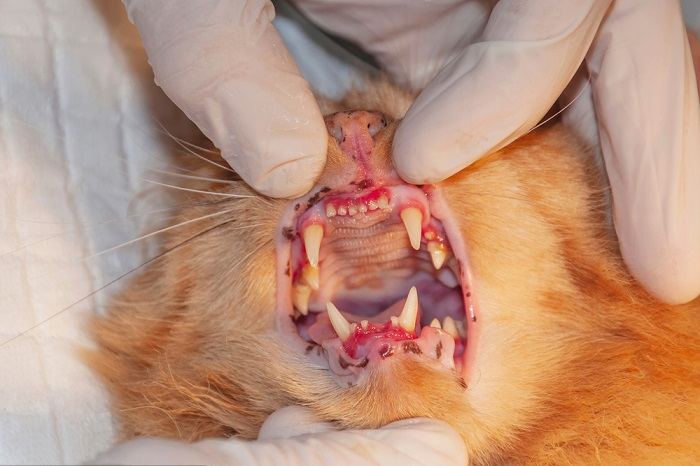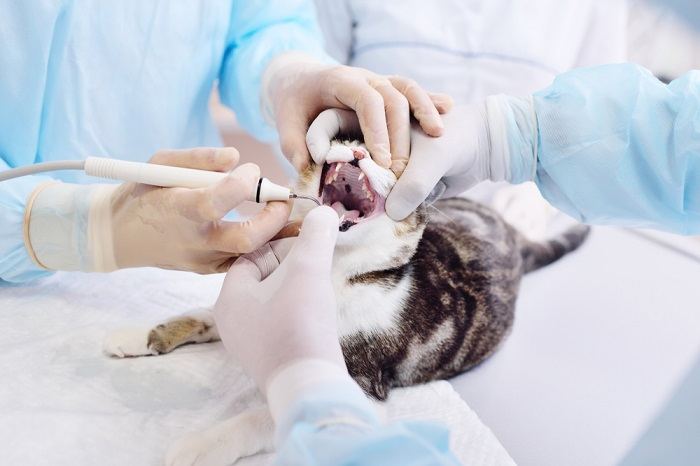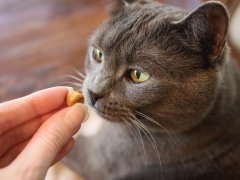
We all know how important dental hygiene is for our general health and well-being. By practicing regular tooth brushing and taking the time for a routine dental checkup, we prioritize our oral health. But what about our cats? Do their teeth need maintenance, too?
Kittens lose their milk teeth around 3 months of age and gain their adult permanent teeth, which should last them a lifetime. Adult cat dental disease and tooth loss are common, and often due to gingivitis, periodontal disease, infection, or trauma. Optimizing dental health is important to reduce dental disease and the associated pain, infection risk, and tooth loss.Key Takeaways
Cats lose teeth in two ways: the natural loss of kitten teeth as they grow into adult cats and the loss of adult teeth due to dental issues. Let’s learn more about your cat’s teeth, and how to prevent adult tooth loss.
A Cat’s Mouth: The Basics
Cats are born with no teeth at all! Their deciduous teeth erupt at around 2 weeks of age. As kittens, cats have 26 baby teeth (also called milk teeth), which are replaced by 30 adult cat teeth by around 3 to 6 months of age. These 30 are made up of 12 incisors, 10 premolars, four molars and four canines. Cats should keep these permanent adult teeth for their entire life.
Cats have different types of teeth, which are used for different functions. Cats are carnivores, and therefore cat teeth are well-developed for hunting prey. The large, sharp canine teeth are long and pointed to allow deep bites and a stronghold.
Their premolars and molars are used for tearing through meat and crunching bone. The small incisors at the front of the mouth grip onto prey, but are also used in grooming. Cats can only move their jaws up and down, so they cannot chew food the same way humans do.
The First Tooth Loss: Kittens
Cats, just like humans, are known as diphyodonts: they have two sets of teeth throughout their life. Kittens develop their first set in the first few weeks of life, and these milk teeth are then replaced by adult teeth from around 4 months old.
Kitten teeth are tiny, so you might not find any of the discarded baby teeth, but you might see some mild redness to the gums if you look in a young cat’s mouth, or spot actual adult teeth emerging from the gum line. Cats can suffer from teething pain just like human babies, which is why kittens need lots of suitable toys to chew on.
Later Tooth Loss: Older Cats
Permanent adult teeth ideally remain in place and useful for your cat’s whole life, but there are some scenarios in which teeth may be lost. Dental disease is common in cats, with studies showing that it is one of the most common problems noted in cats visiting veterinary clinics.1
The statistics are staggering, with studies showing that 70% of cats more than 2 years old suffer from dental disease.2 If dental health is not maintained, various consequences can result, including gum disease, pain, and tooth loss.
How Does Tooth Loss Happen?

Gingivitis, a painful inflammation of the gums, can progress to periodontal disease and tooth loss.
The first stage of dental disease is a build up of plaque. Plaque is the tiny film of bacteria that lines the surface of the tooth but then hardens into tartar if not regularly cleaned away with adequate dental care. This tartar (or calculus) is a hard, brown substance that can be seen on the tooth surface, but it is difficult to remove by simple brushing as it is very solid.
As this tartar accumulates, it attracts bacteria and more food particles. The bacteria colonize around the gum line and lead to gingivitis: an inflammation of the gums that leads to a red, swollen, and sore gum line.
This inflammation can progress to more severe disease, including periodontal disease such as periodontitis, where the gum is so inflamed it weakens the jaw and leads to tooth loss. Cats, although they don’t get cavities as humans do, are also prone to resorptive lesions which are painful and often cause further tooth loss.
Cats can also lose teeth due to trauma, such as a fall from a height, or a road traffic accident. Fractured teeth may need to be extracted or repaired, depending on the level of damage. Exposed pulp (the inner, sensitive part of the tooth) can be very painful if left open.
Signs of Dental Disease in Cats
You might think that poor oral health and dental pain would be easy to spot in cats, as they would stop eating. Or would they? Cats have strong survival instincts and will often keep eating despite severe dental issues.2 Here are some more common symptoms of dental disease to look out for:
- Bad breath (halitosis)
- Drooling
- Blood-tinged saliva (pink)
- Pawing at the mouth
- Teeth chattering
- Dropping food from the mouth when eating
- Getting fussy or picky about food
If your cat is showing any of these signs, schedule a checkup with a veterinarian.
4 Tips To Maintaining Your Cat’s Oral Health
Prevention is better than cure, and optimizing dental health is the best way to protect your precious cat from dental pain and tooth loss.
1. Tooth Brushing
Just as in humans, tooth brushing is the optimal way of reducing plaque and keeping gums healthy. Use a toothpaste that is designed for cats—human toothpaste is not safe for cats.Cat toothpaste also comes in cat-friendly flavors like chicken, tuna, or malt, which is appealing to them. Start by getting your cat used to the paste by smearing a little in their mouth.
Use a cat toothbrush and start very slowly, gradually building up to some short, gentle sessions of tooth brushing. Give lots of praise and rewards when your cat cooperates. Try to incorporate this excellent habit into your routine.
2. Alternatives To Brushing
If you’re struggling with tooth brushing, you’re not alone! It can take time and patience, and some cats aren’t hugely tolerant of such procedures. If you’re looking for an alternative, there’s nothing as effective as brushing, but there are some dental treats and dental chews available.
Another suggestion is to use a product that is added to your cat’s water that aims to reduce plaque formation, although care must be taken that these don’t put your cat off drinking their water. Look for products with the VOHC (Veterinary Oral Health Council) seal of approval.
3. Diet
It has been shown that feeding dry cat food to cats may help promote good oral health2. This is due to the abrasive nature of the dry food (kibble) against the tooth surface, reducing the build-up of plaque and therefore tartar.
4. Professional Dental Cleanings

Most cats benefit from a yearly dental cleaning done in your vet’s office under sedation or general anesthesia.
It can be difficult to get a good look inside your pet’s mouth, especially at the back premolar and molar teeth. Regular dental checks with a veterinary professional are recommended. If any dental disease is suspected, your vet might advise a full examination under anesthesia or sedation, and oral x-rays.
Dental problems are always best to be sorted early and quickly, to prevent the pain associated with oral disease, and to protect the teeth from loss. Many cats will require a veterinary tooth cleaning every year or so, especially as they get older.
Cat Tooth Loss: Summing Up
Cats lose their kitten teeth around 3 months old and gain their adult teeth, which should last them for life. Sadly, dental disease is extremely common in cats and can lead to tooth loss. Optimizing dental hygiene is essential for minimizing dental disease and avoiding painful conditions.
Also Read: Basepaws Cat Dental Health Test Review: We Tried It
Frequently Asked Questions
Is it normal for cats to lose their teeth?
Kittens lose their baby teeth from 3 months old, but adult cats should keep their permanent teeth for life. Sadly, dental disease is extremely prevalent in cats, and tooth loss through trauma or disease is common.
What would cause a cat’s teeth to fall out?
Deciduous teeth in cats fall out from around 3 months and are replaced by adult teeth. These are permanent and only fall out due to trauma, or dental diseases such as periodontitis or resorption.
What to do when a cat's teeth fall out?
It is normal for kittens from about 3 months old to lose their baby teeth. If adult teeth are being lost, seek veterinary advice. It is likely that your cat has significant dental disease if tooth loss is seen.
-
O’Neill, D., Church, D., McGreevy, P., Thomson, P. & Brodbelt, D. (2014). "Prevalence of disorders recorded in cats attending primary care veterinary practices in England." The Veterinary Journal, 202(2), 286-291.
-
Mata, F. (2015). "The choice of diet affects the oral health of the domestic cat." Animals (Basel), 5(1), 101-109.







